| Article ID | Journal | Published Year | Pages | File Type |
|---|---|---|---|---|
| 10269177 | Electrochimica Acta | 2011 | 7 Pages |
Abstract
Applying the model equations shows that the gas-evolution efficiency is significantly smaller than unity in the total range of current density applied in laboratory as well as in nearly all industrial reactors. The impact of the bubble coverage as observed from experimental data is confirmed. Moreover, mass transfer of dissolved gas from the electrode to liquid bulk has decisive influence. The over-all mass transfer rate results from the combined action of several competing mass transfer mechanisms. At low values of the current density, free convective mass transfer mechanisms of various origins dominate. In this case, the electrode height is an important parameter explaining the enormous scatter of experimental data. The dominating impact steadily shifts to microconvective mass transfer as the current density is increased.
Related Topics
Physical Sciences and Engineering
Chemical Engineering
Chemical Engineering (General)
Authors
H. Vogt,
